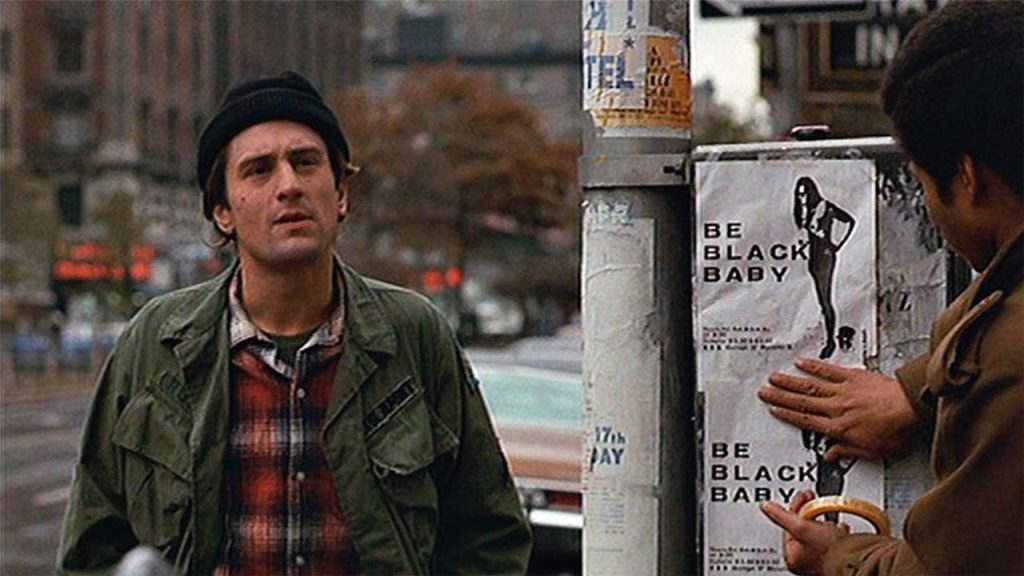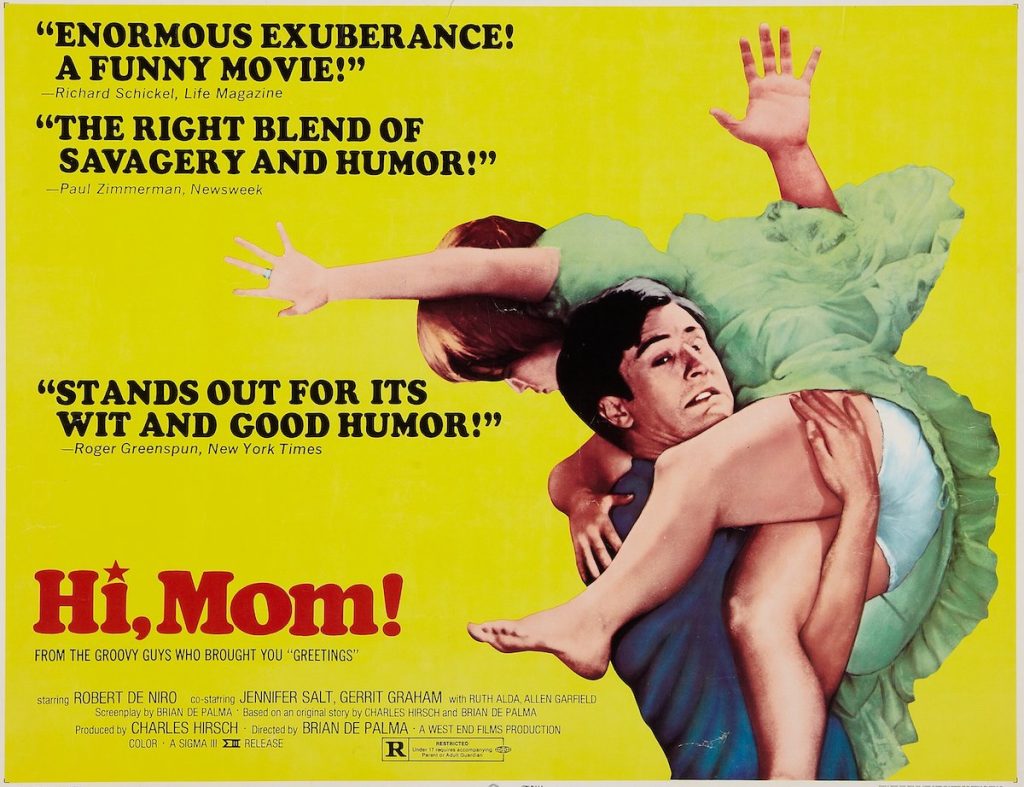When we last saw Jon Rubin he was in the jungles of Southeast Asia, attempting to coax a comely Viet Cong girl into taking off her clothes for the camera. As played by Robert De Niro in one of his earliest and oddest roles, Rubin’s leering voyeur stole the show in Brian De Palma’s ramshackle 1968 draft-dodger ensemble Greetings. The X-rated counterculture farce was an artistic and commercial breakthrough for the filmmaker, which he followed almost immediately with 1970’s Hi, Mom! Originally titled Son of Greetings, it’s an even wilder and ruder romp following the socially maladroit Rubin through various underground Greenwich Village subcultures upon his return from the war. By no means De Niro’s most famous portrayal of a disturbed Vietnam Vet, Rubin could be seen as a an early, comedic tryout for Taxi Driver, in which the bumbling, sexually frustrated former soldier tries to make his mark as a pornographer, an experimental theater performer, and eventually, a domestic terrorist.
This was De Palma’s Godard era, shortly before he pledged allegiance to Alfred Hitchcock. But as is the case with the director’s homages, however explicit, they still feel filtered through his singular sensibility. Despite its blackout sketch structure and improv comedy hijinks, Hi Mom! is unmistakably a Brian De Palma picture: endlessly self-reflexive, obsessed with ways of watching and being watched, always implicating the audience in the action with a wicked cackle. It’s basically the same story as Body Double, chronicling a young peeping Tom’s pet perversions while playfully reminding us that cinema itself is founded on similar predilections.
Rubin’s obsession with capturing “a private moment” on camera has followed him home from Vietnam. He talks a cut-rate pornographer (the hilarious Allen Garfield) into financing his dream project. Rubin has rented a crummy tenement across the street from high-rise apartment building, and spends his days pointing a camera into the windows of his neighbors. The first in a career full of nods to Hitchcock’s Rear Window, Hi, Mom! takes Jimmy Stewart’s nosiness one step further as De Niro attempts to insert himself into the narrative. Rubin comes up with a convoluted means of seducing a single gal across the way (Jennifer Salt) and turning his own residence into a Rube Goldberg camera setup so that he can film himself having sex with her in her apartment.
Such an endeavor requires extremely precise timing, with a wrench thrown into the works when she’s hot to trot the moment he walks in. It’s odd that De Niro’s late-career pivot to comedy was greeted as such a surprise given the slapstick shenanigans of these early De Palma pictures. In Hi, Mom! he tries on a whole bunch of silly accents, making great hay out of a high-pitched affectation that Rubin seems to think connotes being “cultured.” (For years my friends and I tried to mimic the high dudgeon with which De Niro exclaims, “I’ll be damned!”)

The movie’s most notorious sequence comes when Rubin joins a radical African-American theater troupe, playing a police officer in a production called “Be Black Baby.” The avant-garde performance art piece lures members of the moneyed Manhattan elite downtown, where they’re painted in blackface and horrifically abused by the Black actors – who are all wearing whiteface makeup and screaming racist slurs. The theatregoers are robbed, beaten and sexually assaulted until a cop (De Niro) interrupts, refusing to believe any of the battered audience members and only listening to the actors wearing whiteface. The sicko punchline to the sequence finds these upper crust liberals all raving about the experience afterwards, discussing how much they’ve learned about oppression and now they really understand how it feels to be Black.
Hi, Mom! was out of official circulation for many years, and I remember a friend finally tracking down a VHS copy when we were in college. That night, we all stared at the screen in slackjawed awe at “Be Black Baby.” Watching it today, it’s still difficult to believe what you’re watching. The sequence is supposed to be part of a documentary on the film’s PBS parody, National Intellectual Television. (My favorite throwaway gag is that NIT’s sister radio station has a show called “Music To Write Checks By.”) But somewhere along the line, De Palma abandons the mockumentary gambit and plunges us directly into the dislocation and horror of what’s happening. By the time he pulls back for the punchline, the laughs can’t help but stick in your throat. It’s one of the most audacious things I’ve ever seen.
The bitter social satire – in which wealthy liberals turn being raped and beaten into a hobby that makes them feel better about themselves – is presumably why De Palma seemed like the perfect director to adapt Tom Wolfe’s The Bonfire of the Vanities. Alas, that project was doomed before it even started filming by the sheepish studio’s attempts to make the characters more likable. Such a compromise is of no concern with a run-and-gun independent effort like Hi, Mom!, which plunges into even chillier depths for its final act, during which Rubin goes undercover with the bourgeoisie and brings his obsession with that high-rise apartment complex to its only logical end. The last time we see Jon Rubin, he’s smiling for the camera.
“Hi, Mom!” is streaming on Amazon Prime Video, Tubi, and Plex.

